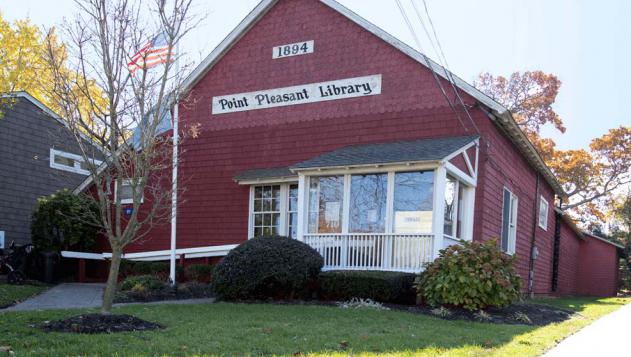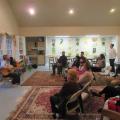On September 2, 1609, Henry Hudson and the crew of his ship, Half Moon, noticed Point Pleasant Beach on their way north to explore the Hudson River. Crewmember, Robert Juet, noted in his journal, “This is a very good Land to fall with and a pleasant Land to see.” The Borough of Point Pleasant Beach was established 277 years later on June 2, 1886.
Originally a seashore playground for the Leni Lanape Indians, settlers arrived during the 1700s. Fishermen and farmers by trade, many owned hundreds of acres of land. Summer tourism began in the early 1800s, when Thomas Cook, Jr. opened his farmhouse on the site of the current Antrim Elementary School to boarders. Soon, the four or five other farm families who owned most of the local property was also taking in guests. The fee of $8-12 a week for room and board would often include meals and a wagon ride through the cornfields to the beach. Visitors enjoyed the seclusion, cool sea breezes, picnicking in cedar groves along the Manasquan River, fishing and hunting. They probably did not drink or party, as Cook and other early landowners were devout Quakers.
Captain John Arnold did the most to establish Point Pleasant Beach as a destination for visitors in the 1870s, when he retired from a career at sea and bought land. In 1870, he built a roadway to the ocean, now known as Arnold Avenue. In 1875, he was instrumental in building the first bridge over the Manasquan River to Brielle. Later, he convinced the Central Jersey Railroad to extend its service to Point Pleasant Beach by giving it right-of-way, land for a depot, and about $6,000 cash. On July 3, 1880, the first passenger train rolled into Point Pleasant Beach.
The 1870s was also an era of major tourism expansion, driven by developers who subdivided old farms for vacation home lots. Captain Arnold devised Arnold City between Central and what was to become Arnold Avenue. In 1877, the Point Pleasant Land Company bought the old Forman Farm, 250 acres on what is now Route 35 South, between Forman and Elizabeth Avenues, and began selling lots. To attract buyers, it built the Resort House in 1878 and began horse-drawn trolley service for tourists.
The grand four-story, 200-guest Resort House was, by far, the largest building in town. It featured shaded groves of oak and locust, a velvet lawn and a commanding view of the beachfront dunes. Inside, was a ballroom and bowling alley. About a half dozen other gracious hotels were built before the turn-of-the-century. The Leighton was the largest, located on the dunes between Forman and Trenton Avenues. The Beacon Hotel, on 18 acres of oceanfront near the Bay Head border, advertised the beneficial qualities of its spring water. Zimmerman’s on Bay Avenue, now a residential hotel, emphasized ’92 New York trains, 20 Philadelphia trains, trolley lines, water works, electric light plants and no mosquitoes. Many of these edifices, including the Resort House, burned to the ground, while others succumbed to changing tastes in lodging. The Leighton was dismantled for scrap wood during World War II.
Boardwalk enthusiasm came relatively late. In the earliest years, visitors focused their attention on the Manasquan River, cedar groves and farmhouses; but eventually, wanted to be near the ocean. The first beachfront pavilion was constructed on Atlantic Avenue in 1880. Ten years later, the first boardwalk was built—a flimsy, portable structure. It washed away within two years.
Around 1892, visitors flocked to Clark’s Landing, the original amusement area, on the Manasquan River in Point Pleasant. It featured a merry-go-round with a steam organ and ice cream making machine. In 1896, a small snack shack on the Manasquan Inlet served coffee, sandwiches, ice cream and pie. In 1897, the decision for privately owned beaches in Point Pleasant Beach was made when, as noted in the August 16th Council minutes, “Ownership of the Beach turned down by the Council because of the extreme cost to the Borough for maintenance.”
The first permanent boardwalk, which ran between Philadelphia and Central Avenues, came in 1915. It would eventually be expanded to run the entire length of Point Pleasant Beach; but was shortened to its present length by the hurricane of September 1938, which destroyed the southern portion. The boardwalk was slowly transformed from a place to stroll to an active amusement area. It was already the long-time home of a merry-go-round and several other amusements when, in the late 1920s, Orlo Jenkinson built Jenkinson’s Pavilion and Swimming Pool. The boardwalk pavilion became the place to go for a night of sophisticated dancing to well-known big bands. Sometimes, a live nationally broadcast radio hookup added to the excitement.
Nowadays, Point Pleasant Beach has a thriving downtown business district, hosting diverse shopping experiences, as well as premiere antique establishments. It is famous for its annual Seafood Festival in September. The Boardwalk is home to a first class aquarium, as well as rides, arcades and diverse dining experiences, ranging from the traditional sausage sandwich to sushi.
Source: History of Point Pleasant Beach. Retrieved from http://www.pointpleasantbeach.org/general-history.php






